
There are plenty of ways to create timelapse videos, but [Andy] has an efficient method for ensuring up-to-date ones exist for his infrared sky camera, and he has it running thanks to some well-documented shell scripts on a spare Raspberry Pi. The resulting timelapse video is always available from the web, and always up-to-date for the current day.
The idea is to automatically fetch images from a remote source (in his case, an infrared sky camera) and turn them into a cumulative video that is regularly updated for the day in question. The resulting video file is either served from the same machine, or sent elsewhere. All that’s needed besides a source for the stills are two shell scripts and some common Linux utilities.
Since [Andy] is mainly interested in tracking clouds his system only runs during daylight hours, but it can be easily changed. In fact, [Andy]’s two shell scripts are great project resources, not only because they are easily modified and well documented, but because he doesn’t make assumptions about how well one might know the command line. He also provides tips from experience; for example he has found that a 120 second interval makes for the best timelapses.
[Andy] runs his scripts on an Raspberry Pi 4, but any Linux system will do. For those who might prefer a more embedded approach, the ESP32-CAM can make a great time lapse camera with remarkably little effort.
















I really like this! I did something similar with a Pi Zero W, also with bash scripts, but I have it moving the files via rsync to another more powerful server where I build the time lapse video with ffmpeg. Documentation here:
https://miscdotgeek.com/time-lapse-camera-with-the-raspberry-pi-zero-w-part-2/
This reminds me of making stop-motion lego videos with my kids. ffmpeg is probably long since out of date, but it got the job done then.